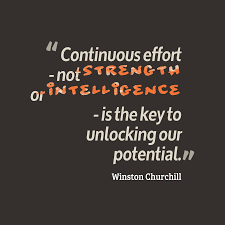Rule #3: Do The Work
Show me a person you trust to draft the baseline strat plan for the division, or whip up a piece of effective code that shows data in a way you can’t currently see it, or frame an important idea into a PowerPoint presentation that simplifies the idea into a set of consumable thoughts and visuals; and I’ll show you a person who’s worked really, really hard at doing just that, hundreds, if not thousands, of times before. Skill is fundamental to effective leadership. Skill is developed through time, repetition and attention to detail focused on a specific task.
An expert in a particular type of surgery is usually the physician who’s performed that specific surgery more than any other surgeon. An expert in contracts can show you where and how every paragraph and clause in an agreement has served an important partnership, saved it, or severed it. An expert data manager can share stories of how the presence or absence of a single digit or field, added months of tedious rework to a project or immediately enhanced a business leader’s ability to see trends and make fact-based, data-driven connections and decisions.
Skill is often referred to as mastery. Leaders are often referred to as Masters. Mastery of a particular skill or set of skills comes from time, LOTS of time, energy, and effort spent in repetition performing a single act. Mastery is code for hard work. Doing something again and again and again teaches you all the unintended outcomes of an action and all the flaws in critical thinking that predate that action. Dedication to a particular task builds confidence in your ability to predict the likely result of an action. Exerting continuous effort to a task or series of tasks shows anyone who’s watching that you possess the discipline, dedication, and determination that will elevate you to a trusted leadership position.

CEO.com, a leadership resource for business executives, conducted a survey in 2015, on how CEOs spend their time. The survey respondents included 256 CEOs, all of whom said they work on average 10 to 11 hours a day. In a white paper that detailed the results, the surveyed CEOs said they work very hard and work —a LOT. The CEOs and C-level executives surveyed showed devotion to their brands, investing years of blood, sweat, and tears, high-intensity work weeks, and taking only a few vacation days per year. In an excerpt from the white paper, Susan Wojcicki, YouTube’s CEO, shared her thoughts this way:
“At the end of the day, both men and women who become CEOs have shown tenacity and hard work to succeed in their careers, (…) It takes not just skills but also extreme dedication and commitment.” – Susan Wojcicki, YouTube CEO
I’m setting up the foundation for Strong Point’s Leadership Rule #3: Do the Work. It’s obvious. Skill is acquired through gritty and continuous effort. You have to Do the Work to gain insights, confidence, and skill. Skill leads to Mastery. Mastery is what separates Leaders from the rest of the pack.
What isn’t so obvious is what happens after mastery occurs and how the mastery of a leader is used to impart leadership. Mastery clearly sets leaders apart from the pack. Many leaders today think once mastery of a certain set of skills is achieved, and once the breakaway from the pack occurs, leaders have the ability and the prerogative to now LEAD the work of the doers – and not necessarily DO the work of the doers. So prevalent is the belief that leaders should not DO the Work of the organization, but rather delegate, inspire, motivate and manage the work of other leaders and teams, that I feel compelled to share Strong Point’s view on Rule #3: Do the Work. There’s more to this Rule #3 than time and grit can convey. It’s this: Doing the work with and for your team does more to teach and solidify leadership than simply leading the team. Let me say it another way: people learn to lead more through experiential learning, and through working partnerships, than through listening and watching alone.
Let me provide an example. In a particularly powerful Strong Point engagement focused on helping a senior IT leader reduce, rationalize and optimize the technology infrastructure in support of preclinical development for a global pharmaceutical company, two internal leaders; one in the Pharmaceutical Science community and one in the Information Technology community had a history of mistrust. Trust between these two leaders and organizations was so low, that the Science Community invested in a “Shadow IT” infrastructure that was larger than the IT group could manage effectively. Not only did the science community have more than 3 instances of the same technology platform; the overall infrastructure had become increasingly piece-meal and complex. Worse, the Science community “owned” more of the technology infrastructure than the IT team did. The IT organization, at the start of the engagement, struggled to identify and map the systems and applications in place to support scientific development, let alone develop a plan to support the technology infrastructure.
What began as a technology optimization endeavor quickly turned into a leadership skill building effort. The IT Leader’s senior-staff clearly had to do things differently from what was done in the past. Strong Point’s guidance to the IT Leadership in this instance was twofold:
- 1 – Treat the Science Leaders and their sphere of influence they way you would treat external customers
- 2 – Reinvent your customer engagement model
When the IT Leaders began to meet their internal customers in the Science Community, as if for the first time, and explore the needs and business imperatives behind each shadow IT implementation, it became clear that scientific discovery was taking turns and pivots quicker than the IT support team was able to respond. Science leaders felt unsupported and their rapidly changing needs felt unmet.
To be successful at reinventing the internal customer engagement model, the IT Team had to step back and learn more about the compound development pipeline of the company and specifically about the medicines in development. An interview with a lead enzymologist, for example, revealed that this science customer was so frustrated with IT’s inability to automate her scientific discovery process; that she began researching and evaluating technology solutions herself. Had the IT leadership known more about the specific needs, pains and challenges of their scientific partners, like this one; their partnership, and trust for each other, would have been on stronger ground.
As the engagement progressed, both the Science and IT leaders got more involved in each other’s work. Indeed, they started co-developing, joint strategic plans. In the past, they had developed their own respective strategic plans and shared them intellectually and visually with each other. By actually writing a joint strategic plan and interactively and critically thinking about the review and revision criteria necessary to change plans, their knowledge, trust and support of each other grew. I dare say, the leadership capability of all leaders involved in the joint planning process also grew. Stakeholders near and around their sphere of influence noticed the rise in excitement, productivity, effectiveness, and output. Real change was occurring in the Science and IT partnership and the authentic power of individuals and teams was unleashed.
Strong Point has learned that a participatory style of leadership is very effective in motivating, teaching, enhancing and advancing skills of individuals and teams. Improving the leadership skills of individuals, works to advance the leadership capability of business units and the company at large. Leaders who view their teams as a multi-disciplined and diverse group of professionals on a shared journey exhibit this “Do The Work” mentality best. Here is the self talk I imagine hearing from such a leader: “Even though I am the master with the vision and the compass, if I participate and “work” with my team and they know the work and the way as well as I do; I can hand-off the compass, and give the reigns and the strategic roadmap to anyone here. They will follow-through with my trusted support. Any one of them can cover for me when I am away, strengthen me and the team when the going gets rough, and even see or create a shorter, more effective route to the finish.” This is why doing the work is so important to effective leadership. Strong Point Strategy is not the only organization that holds this view.
I’ll reference another White Paper published by ChiefExecutive.Net entitled Engaging CEOs Here are some thoughts shared in the document about leaders “doing the work:”
Although conventional marketing wisdom holds that CEOs are “above” downloading white papers, attending conferences, reading email newsletters, or other information-gathering techniques, a growing body of research and anecdotal evidence suggests otherwise. Why?
As Taylor suggests, it is on CEOs’ shoulders that the responsibility falls to identify signs of change to which their organizations must respond. In fact, 96% of nearly 500 CEOs surveyed by Chief Executive Group (CEG) say their role in being “watchful” for significant needs or opportunities throughout their organizations is “important,” “very important” or “primary.”
One way to remain watchful of changing competitive landscapes, emerging market trends, and the inner workings of your teams, is to stay close to them and to work along-side them, in some capacity. The strengths and weaknesses of your collective work burn through in an overt way when you do this. In his book Way to Inner Peace, the author, Fulton J. Sheen, writes an essay on Perfection. In his essay he explains that real thirst for knowledge, which for the sake of illustration, we can equate to passion for reaching a goal, comes from recognizing your own weaknesses. I see this all the time in my work through Strong Point. Leaders who share their mastery in a day-to-day manner with their colleagues and subordinates, keep the many schools of thought flowing among a diverse and talented group of people, swimming in the same direction. Leadership, through working partnerships, reveals itself through serving, supporting, sharing workloads, showing restraint, self-sacrifice, and self-discipline. It’s harder for people and teams to get out of synch with leaders who do the work. Leaders who Do the Work strengthen leadership capability within a team, within a sphere of influence and within a company.
Strong Point Leadership Rule #3: Do The Work





